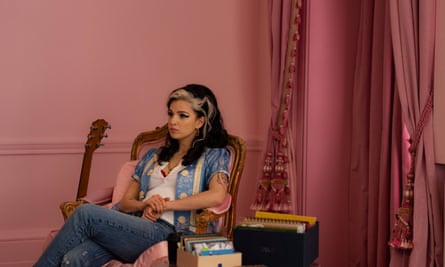Set designers Katie Spencer and Sarah Greenwood went from Barbie to the darker world of the Amy Winehouse biopic. They explain how even a Smeg fridge evokes the singer’s dreams
Imagine someone coming into your bedroom, taking a look around and then recreating it in meticulous detail: they would end up telling your story without ever saying a word.
That was the aim of the set designers for the Amy Winehouse biopic Back to Black, where her various homes feel as integral as Marisa Abela’s detailed study of her vocals and movements. Back to Black is a strange and sanitised telling of Amy Winehouse’s life – and many have criticised it – but the film happens in a very real world. The Camden of the early 00s pulses and buzzes, but it is Winehouse’s own spaces, recreated by set design team Katie Spencer (set decorator) and Sarah Greenwood (production designer), that flesh out the story beyond her voice and her addictions.
On a video call, Spencer and Greenwood – who have worked together for more than 20 years on films including Barbie – speak in harmonious counterpoint. They did a lot of research, including watching Asif Kapadia’s 2015 documentary Amy and poring over photos and descriptions of Amy’s homes, but they didn’t feel beholden to every tiny detail. “We always go from character,” Spencer adds. “And character leads to environment.”
Winehouse was often charming, famously capricious and outwardly confident but inwardly quite unsure of herself: you see these traits in her evolving homes in Back to Black. Her childhood bedroom is portrayed as a slightly unreal place of sanctuary where Abela-as-Winehouse scribbles lyrics and improvises melodies sitting cross-legged on her bed, the walls behind her whitewashed brick. Her first Camden home, a mess of shoe boxes and mugs, features a giant jukebox customised with her own records and handwritten tracklists, the reeded glass of her front door obscuring and distorting every visitor suggesting the dangers that lurk outside. And in her final home, a huge, airy space half-finished with ghostly furniture coverings, she looks as small as a mouse.

Often the sets are coloured by a delightful kind of chaos, cluttered and warm. “What I found really fascinating was how analogue she was,” Spencer says. “She kept all these journals. She sketched and doodled; you never see her with a computer. I love that she was this old fashioned girl.” This pen-and-paper approach bled into Greenwood and Spencer’s work: despite only getting fleeting appearances on screen, in Amy’s teenage bedroom they doodled on the walls, meticulously recreated her diaries and kept everything tech-free.
They amalgamated the flats from Amy’s early 20s, two different locations in Camden into one set on Jeffrey’s Place. If you remember the era, you’ll recognise the outside from endless paparazzi photos. “We were able to shoot the exterior of that and it’s still exactly the same,” Greenwood recalls. “It was such a part of her – a very poignant reminder of who she was.”
They built the downstairs and the bathroom of the Jeffrey’s Place flat in a studio. “The real flat is tiny, about 12 foot wide,” Spencer says. “The house was small, the life was big – you could feel it reverberating against the walls.”
There’s a big Smeg fridge, a model Spencer says Winehouse bought in a “first paycheck moment – certain things you really had to honour”. Another is the jukebox in the film, aptly named AMI: it was Amy’s own, complete with handwritten track listings. They would play it as they dressed the sets, the warm, crackling tones giving a sense of being slightly outside linear time. “Sometimes when we were on set and just dressing a record would come on and you’d be like, ‘Wow, it’s one of her choices’. And it gave everything a kind of ethereal glow,” Spencer recalls.

I say that these feel like faithful recreations, but Greenwood objects. “It’s very much an interpretation of Amy’s places – it’s the same as with the Barbie Dream House, for example. Everyone was like, ‘Oh my god, I had a toy just like that.’ And actually you didn’t, because, in fact, it was nothing like that. What we did was take the essence of it, and make it into something that felt like it is.”
That essence is never more obvious in Back to Black than in the final scenes set in what was to be Amy’s final home. There’s a smattering of character in the rose-pink walls but it has a vast and haunted feel as it’s left mid-decoration. “The essence of that house was that it got so far in the doing up but it wasn’t complete. It was striving for something, a more mature and sophisticated version of where she’s come from. But there’s something missing,” Greenwood says. “There’s something a bit soulless about it. Just the jukebox, a massive ladder and a lovely carpet.”
“It felt moving,” Spencer says. “Because you know what’s coming. We all know what’s coming.”
“And you feel agitated,” Greenwood says. “If whatever could have carried her through that moment, she would have had a life in that house. It just never flowered.”

